Biomimetic Polarized Light Navigation Sensor: A Review
Abstract
1. Introduction
2. Biomimetic Polarized Light Navigation in Nature
3. Biomimetic Polarized Light Navigation Mechanism
4. Research Progress of Bionic Polarized Light Navigation Sensor
4.1. Point Source Polarized Light Sensor Based on POL Neuron Model
4.1.1. Basic Point Source Polarized Light Sensor
4.1.2. Point Source Sensor for Integrated Navigation
4.2. Imaging Polarized Light Sensor
4.2.1. Sensor Based on Time-Sharing Imaging System
4.2.2. Divided Amplitude Sensor Based on Real-Time Imaging System
4.2.3. Aperture Dividing Sensor Based on Real-Time Imaging System
4.2.4. Focal Plane Spectroscopic Sensor Based on Real-Time Imaging System
4.3. Polarized Light Sensor Based on Micro-Nano Processing Technology
5. Conclusions and Outlook
Author Contributions
Funding
Institutional Review Board Statement
Informed Consent Statement
Data Availability Statement
Conflicts of Interest
References
- Rao, R.Z. Modern Atmospheric Optics; Science Press: China, Beijing, 2012; pp. 12–25. [Google Scholar]
- Lambrinos, D.; Kobayashi, H.; Pfeifer, R.; Maris, M.; Labhart, T.; Wehner, R. An autonomous agent navigating with a polarized light compass. Adapt. Behav. 1997, 6, 131–161. [Google Scholar] [CrossRef]
- Lambrinos, D.; Möller, R.; Labhart, T.; Pfeifer, R.; Wehner, R. A mobile robot employing insect strategies for navigation. Robot. Auton. Syst. 2000, 30, 39–64. [Google Scholar] [CrossRef]
- Chu, J.; Zhao, K.; Zhang, Q.; Wang, T. Construction and performance test of a novel polarization sensor for navigation. Sens. Actuators A Phys. 2008, 148, 75–82. [Google Scholar] [CrossRef]
- Wang, Z.; Chu, J.; Wang, Q.; Zhang, R. Single-layer nanowire polarizer integrated with photodetector and its application for polarization navigation. IEEE Sens. J. 2016, 16, 6579–6585. [Google Scholar] [CrossRef]
- York, T.; Achilefu, S.; Lake, S.P.; Raman, B.; Gruev, V.; Powell, S.B.; Gao, S.; Kahan, L.; Charanya, T.; Saha, D.; et al. Bioinspired polarization imaging sensors: From circuits and optics to signal processing algorithms and biomedical applications. Proc. IEEE 2014, 102, 1450–1469. [Google Scholar] [CrossRef]
- Yaroslavsky, A.N.; Neel, V.; Anderson, R.R. Fluorescence polarization imaging for delineating nonmelanoma skin cancers. Opt. Lett. 2004, 29, 2010–2012. [Google Scholar] [CrossRef]
- Goudail, F.; Tyo, J.S. When is polarimetric imaging preferable to intensity imaging for target detection? J. Opt. Soc. Am. A 2011, 28, 46–53. [Google Scholar] [CrossRef]
- Zeng, X.; Chu, J.; Cao, W.; Kang, W.; Zhang, R. Visible–IR transmission enhancement through fog using circularly polarized light. Appl. Opt. 2018, 57, 6817–6822. [Google Scholar] [CrossRef]
- Tyo, J.S.; Goldstein, D.L.; Chenault, D.B.; Shaw, J.A. Review of passive imaging polarimetry for remote sensing applications. Appl. Opt. 2006, 45, 5453–5469. [Google Scholar] [CrossRef]
- Hein, G.W. Status, perspectives and trends of satellite navigation. Satell. Navig. 2020, 1, 22–34. [Google Scholar] [CrossRef]
- Woodman, O.J. An introduction to inertial navigation (No. UCAM-CL-TR-696). Univ. Camb. Comput. Lab. 2007, 696, 1–37. [Google Scholar]
- Van Allen, J.A. Basic principles of celestial navigation. Am. J. Phys. 2004, 72, 1418–1424. [Google Scholar] [CrossRef]
- Yang, G.; Liu, T.; Zhou, A.; Jiang, C.; Hu, Y.; Zhao, Z.; Ni, B. A novel land-based high-frequency geolocation system. IEEE Geosci. Remote Sens. Lett. 2020, 18, 48–52. [Google Scholar] [CrossRef]
- Zong, H.; Liu, Y.; Yang, Y. Overview of the Research Status about Geomagnetic Navigation Technology. Aerosp. Control 2018, 36, 93–99. [Google Scholar]
- Geva, A.; Rivlin, E.; Rotstein, H. Comparative performance of two methods for visual terrain assisted navigation. In Proceedings of the 59th Israel Annual Conference on Aerospace Sciences, Tel Aviv, Israel, 1 January 2019. [Google Scholar]
- Xian, P.; Ji, B.; Bian, S.; Liu, B. Influence of sea level anomaly on underwater gravity gradient measurements. Sensors 2022, 22, 5758. [Google Scholar] [CrossRef]
- Dupeyroux, J.; Viollet, S.; Serres, J.R. An ant-inspired celestial compass applied to autonomous outdoor robot navigation. Robot. Auton. Syst. 2019, 117, 40–56. [Google Scholar] [CrossRef]
- Collett, M.; Collett, T.S.; Bisch, S.; Wehner, R. Local and global vectors in desert ant navigation. Nature 1998, 394, 269–272. [Google Scholar] [CrossRef]
- Bech, M.; Homberg, U.; Pfeiffer, K. Receptive fields of locust brain neurons are matched to polarization patterns of the sky. Curr. Biol. 2014, 24, 2124–2129. [Google Scholar] [CrossRef] [PubMed]
- Cartron, L.; Darmaillacq, A.S.; Jozet-Alves, C.; Shashar, N.; Dickel, L. Cuttlefish rely on both polarized light and landmarks for orientation. Anim. Cogn. 2012, 15, 591–596. [Google Scholar] [CrossRef]
- Reppert, S.M.; Gegear, R.J.; Merlin, C. Navigational mechanisms of migrating monarch butterflies. Trends Neurosci. 2010, 33, 399–406. [Google Scholar] [CrossRef]
- ADyer, A.G.; Greentree, A.D.; Garcia, J.E.; Dyer, E.L.; Howard, S.R.; Barth, F.G. Einstein, von Frisch and the honeybee: A historical letter comes to light. J. Comp. Physiol. A 2021, 207, 449–456. [Google Scholar]
- Chen, Z. Application of Polarization Camera Based on Pixel Polarization Array in Bionic Polarization Navigation. Master’s Thesis, China Jiliang University, Hangzhou, China, 2020. [Google Scholar]
- Chu, J.; Zhang, R.; Wang, Z.; Wang, Y. Progress on bio-inspired polarized skylight navigation sensor. Chin. Sci. Bull. 2016, 61, 2568–2577. [Google Scholar] [CrossRef]
- Chu, J.; Guan, L.; Li, S. Atmospheric polarization field pattern distribution and polarization navigation technology. J. Remote Sens. 2018, 22, 969–979. [Google Scholar]
- Chu, J.K.; Guan, L.; Li, S.Q. Bio-inspired polarization detection technology and navigation sensor applications. Metrol. Meas. Technol. 2021, 41, 23–33. [Google Scholar]
- Zhang, X.; Wan, Y.; Li, L. Bio-inspired polarized skylight navigation: A review. MIPPR 2015 Remote Sens. Image Process. Geogr. Inf. Syst. Other Appl. 2015, 9815, 274–281. [Google Scholar]
- El Jundi, B.; Baird, E.; Byrne, M.J.; Dacke, M. The brain behind straight-line orientation in dung beetles. J. Exp. Biol. 2019, 222, jeb192450. [Google Scholar] [CrossRef]
- Karman, S.B.; Diah, S.Z.M.; Gebeshuber, I.C. Bio-inspired polarized skylight-based navigation sensors: A review. Sensors 2012, 12, 14232–14261. [Google Scholar] [CrossRef] [PubMed]
- Chahl, J.; Mizutani, A. Biomimetic attitude and orientation sensors. IEEE Sens. J. 2010, 12, 289–297. [Google Scholar] [CrossRef]
- Gkanias, E.; Risse, B.; Mangan, M.; Webb, B. From skylight input to behavioural output: A computational model of the insect polarised light compass. PLoS Comput. Biol. 2019, 15, e1007123. [Google Scholar] [CrossRef]
- Zhao, K.; Chu, J.; Wang, T.; Zhang, Q. A novel angle algorithm of polarization sensor for navigation. IEEE Trans. Instrum. Meas. 2009, 58, 2791–2796. [Google Scholar] [CrossRef]
- Wang, Y.; Chu, J.; Zhang, R.; Li, J.; Guo, X.; Lin, M. A bio-inspired polarization sensor with high outdoor accuracy and central-symmetry calibration method with integrating sphere. Sensors 2019, 19, 3448. [Google Scholar] [CrossRef]
- Dupeyroux, J.; Viollet, S.; Serres, J.R. Polarized skylight-based heading measurements: A bio-inspired approach. J. R. Soc. Interface 2019, 16, 20180878. [Google Scholar] [CrossRef] [PubMed]
- Stokes, G.G. On the composition and resolution of streams of polarized light from different sources. Trans. Camb. Philos. Soc. 1851, 9, 399. [Google Scholar]
- Labhart, T. Polarization-opponent interneurons in the insect visual system. Nature 1988, 331, 435–437. [Google Scholar] [CrossRef]
- Dupeyroux, J.; Serres, J.R.; Viollet, S. AntBot: A six-legged walking robot able to home like desert ants in outdoor environments. Sci. Robot. 2019, 4, eaau0307. [Google Scholar] [CrossRef]
- Du, T.; Tian, C.; Yang, J.; Wang, S.; Liu, X.; Guo, L. An autonomous initial alignment and observability analysis for SINS with bio-inspired polarized skylight sensors. IEEE Sens. J. 2020, 20, 7941–7956. [Google Scholar] [CrossRef]
- Liu, X.; Yang, J.; Guo, L.; Yu, X.; Wang, S. Design and calibration model of a bioinspired attitude and heading reference system based on compound eye polarization compass. Bioinspir. Biomim. 2020, 16, 016001. [Google Scholar] [CrossRef]
- Yang, J.; Liu, X.; Zhang, Q.; Du, T.; Guo, L. Global autonomous positioning in GNSS-challenged environments: A bioinspired strategy by polarization pattern. IEEE Trans. Ind. Electron. 2020, 68, 6308–6317. [Google Scholar] [CrossRef]
- Yang, J.; Du, T.; Liu, X.; Niu, B.; Guo, L. Method and implementation of a bioinspired polarization-based attitude and heading reference system by integration of polarization compass and inertial sensors. IEEE Trans. Ind. Electron. 2019, 67, 9802–9812. [Google Scholar] [CrossRef]
- Zhang, Q.; Yang, J.; Huang, P.; Liu, X.; Wang, S.; Guo, L. Bionic integrated positioning mechanism based on bioinspired polarization compass and inertial navigation system. Sensors 2021, 21, 1055. [Google Scholar] [CrossRef]
- Chu, J.; Wang, H.; Chen, W.; Li, R. Application of a novel polarization sensor to mobile robot navigation. In Proceedings of the 2009 International Conference on Mechatronics and Automation, Changchun, China, 9–12 August 2009. [Google Scholar]
- Zhi, W.; Chu, J.; Li, J.; Wang, Y. A novel attitude determination system aided by polarization sensor. Sensors 2018, 18, 158. [Google Scholar] [CrossRef] [PubMed]
- Wang, Y.; Chu, J.; Zhang, R.; Wang, L.; Wang, Z. A novel autonomous real-time position method based on polarized light and geomagnetic field. Sci. Rep. 2015, 5, 9725. [Google Scholar] [CrossRef] [PubMed]
- Wang, Y.; Chu, J.; Zhang, R.; Shi, C. Orthogonal vector algorithm to obtain the solar vector using the single-scattering Rayleigh model. Appl. Opt. 2018, 57, 594–601. [Google Scholar] [CrossRef]
- Li, J.; Chu, J.; Zhi, W.; Wu, J.; Zhang, R. Integrated Navigation System Based on Polarization Sensor in Small UAVs. In Proceedings of the 2021 International Conference on Autonomous Unmanned Systems (ICAUS 2021), Changsha, China, 24–26 September 2021; Springer: Singapore, 2022. [Google Scholar]
- Zhou, W.; Fan, C.; He, X.; Hu, X.; Fan, Y.; Wu, X.; Shang, H. Integrated bionic polarized vision/vins for goal-directed navigation and homing in unmanned ground vehicle. IEEE Sens. J. 2021, 21, 11232–11241. [Google Scholar] [CrossRef]
- Xie, J.; He, X.; Mao, J.; Zhang, L.; Han, G.; Zhou, W.; Hu, X. A Bio-Inspired Multi-Sensor System for Robust Orientation and Position Estimation. In Proceedings of the 2021 IEEE/RSJ International Conference on Intelligent Robots and Systems (IROS), Prague, Czech Republic, 27 September 2021. [Google Scholar]
- Fan, C.; Zhou, Z.; He, X.; Fan, Y.; Zhang, L.; Wu, X.; Hu, X. Bio-inspired multisensor navigation system based on the skylight compass and visual place recognition for unmanned aerial vehicles. IEEE Sens. J. 2022, 22, 15419–15428. [Google Scholar] [CrossRef]
- Fan, Y.; Fan, C.; He, X.; Hu, X.; Zhou, W.; Wu, X.; Shang, H. Bionic Polarized Skylight Orientation Method Based on the Model Consistency of Polarization Patterns in Cloudy Weather. IEEE Sens. J. 2022, 22, 19455–19465. [Google Scholar] [CrossRef]
- Liang, H.; Bai, H.; Liu, N.; Shen, K. Limitation of Rayleigh sky model for bioinspired polarized skylight navigation in three-dimensional attitude determination. Bioinspir. Biomim. 2020, 15, 046007. [Google Scholar] [CrossRef]
- Hu, P.; Huang, P.; Qiu, Z.; Yang, J.; Liu, X. A 3D attitude estimation method based on attitude angular partial feedback for polarization-based integrated navigation system. Sensors 2022, 22, 710. [Google Scholar] [CrossRef]
- Zhao, D.; Liu, Y.; Wu, X.; Dong, H.; Wang, C.; Tang, J.; Shen, C.; Liu, J. Attitude-Induced error modeling and compensation with GRU networks for the polarization compass during UAV orientation. Measurement 2022, 190, 110734. [Google Scholar] [CrossRef]
- Zhao, H.; Xiong, Y.; Zhao, D.; Wang, C.; Tang, J.; Shen, C.; Liu, J.; Zhao, J.; Zhao, C.; Yan, B. INS/GNSS/Polarized Light Integrated Navigation System Based on CKF. In Advances in Guidance, Navigation and Control: Proceedings of 2020 International Conference on Guidance, Navigation and Control, ICGNC 2020, Tianjin, China, 23–25 October 2022; Springer: Singapore, 2022. [Google Scholar]
- Robert, W. Polarization imagery. Opt. Polarim. Instrum. Appl. 1977, 112, 164–167. [Google Scholar]
- Bishop, K.P.; McIntire, H.D.; Fetrow, M.P.; McMackin, L.J. Multispectral polarimeter imaging in the visible to near IR. Targets Backgr. Charact. Represent. V 1999, 3699, 49–57. [Google Scholar]
- Pust, N.J.; Shaw, J.A. Dual-field imaging polarimeter using liquid crystal variable retarders. Appl. Opt. 2006, 45, 5470–5478. [Google Scholar] [CrossRef]
- Miyazaki, D.; Ammar, M.; Kawakami, R.; Ikeuchi, K. Estimating sunlight polarization using a fish-eye lens. IPSJ Trans. Comput. Vis. Appl. 2009, 1, 288–300. [Google Scholar] [CrossRef]
- Wang, Y.; Hu, X.; Lian, J.; Zhang, L.; Xian, Z.; Ma, T. Design of a device for sky light polarization measurements. Sensors 2014, 14, 14916–14931. [Google Scholar] [CrossRef] [PubMed]
- Ahsan, M.; Cai, Y.; Zhang, W. Information extraction of bionic camera-based polarization navigation patterns under noisy weather conditions. J. Shanghai Jiaotong Univ. (Sci.) 2020, 25, 18–26. [Google Scholar] [CrossRef]
- Foster, J.J.; Kirwan, J.D.; El Jundi, B.; Smolka, J.; Khaldy, L.; Baird, E.; Byrne, M.J.; Nilsson, D.-E.; Johnsen, S.; Dacke, M. Orienting to polarized light at night–matching lunar skylight to performance in a nocturnal beetle. J. Exp. Biol. 2019, 222, jeb188532. [Google Scholar] [CrossRef] [PubMed]
- Gál, J.; Horváth, G.; Barta, A.; Wehner, R. Polarization of the moonlit clear night sky measured by full-sky imaging polarimetry at full Moon: Comparison of the polarization of moonlit and sunlit skies. J. Geophys. Res. Atmos. 2001, 106, 22647–22653. [Google Scholar] [CrossRef]
- Dacke, M.; Nilsson, D.E.; Scholtz, C.H.; Byrne, M.; Warrant, E.J. Insect orientation to polarized moonlight. Nature 2003, 424, 33–34. [Google Scholar] [CrossRef]
- Kyba, C.C.; Ruhtz, T.; Fischer, J.; Hölker, F. Lunar skylight polarization signal polluted by urban lighting. J. Geophys. Res. Atmos. 2011, 116, D24. [Google Scholar] [CrossRef]
- Tang, J.; Zhang, N.; Li, D.; Wang, F.; Zhang, B.; Wang, C.; Shen, C.; Ren, J.; Xue, C.; Liu, J. Novel robust skylight compass method based on full-sky polarization imaging under harsh conditions. Opt. Express 2016, 24, 15834–15844. [Google Scholar] [CrossRef]
- Yang, Y.; Wang, Y.; Guo, L.; Tian, B.; Yang, J.; Li, W.; Chen, T. Bioinspired polarized light compass in moonlit sky for heading determination based on probability density estimation. Chin. J. Aeronaut. 2022, 35, 1–9. [Google Scholar] [CrossRef]
- Barta, A.; Farkas, A.; Száz, D.; Egri, Á.; Barta, P.; Kovács, J.; Csák, B.; Jankovics, I.; Szabó, G.; Horváth, G. Polarization transition between sunlit and moonlit skies with possible implications for animal orientation and Viking navigation: Anomalous celestial twilight polarization at partial moon. Appl. Opt. 2014, 53, 5193–5204. [Google Scholar] [CrossRef] [PubMed]
- Yang, Y.; Hu, P.; Yang, J.; Wang, S.; Zhang, Q.; Wang, Y. Clear night sky polarization patterns under the super blue blood moon. Atmosphere 2020, 11, 372. [Google Scholar] [CrossRef]
- Azzam, R.M.A. Division-of-amplitude photopolarimeter (DOAP) for the simultaneous measurement of all four Stokes parameters of light. Opt. Acta Int. J. Opt. 1982, 29, 685–689. [Google Scholar] [CrossRef]
- Niu, B.; Yang, J.; Du, T.; Wang, G.; Guo, L. Polarization angle measurement by polarizing beam splitter-based sensor. In Proceedings of the 2016 35th Chinese Control Conference (CCC), Chengdu, China, 27–29 July 2016. [Google Scholar]
- Yang, J.; Du, T.; Niu, B.; Li, C.; Qian, J.; Guo, L. A bionic polarization navigation sensor based on polarizing beam splitter. IEEE Access 2018, 6, 11472–11481. [Google Scholar] [CrossRef]
- Yang, J.; Niu, B.; Du, T.; Liu, X.; Wang, S.; Guo, L. Disturbance analysis and performance test of the polarization sensor based on polarizing beam splitter. Sens. Rev. 2019, 39, 341–351. [Google Scholar] [CrossRef]
- Pezzaniti, J.L.; Chenault, D.B. A division of aperture MWIR imaging polarimeter. Polariz. Sci. Remote Sens. II 2005, 5888, 239–250. [Google Scholar]
- Fan, C.; Hu, X.; Lian, J.; Zhang, L.; He, X. Design and calibration of a novel camera-based bio-inspired polarization navigation sensor. IEEE Sens. J. 2016, 16, 3640–3648. [Google Scholar] [CrossRef]
- Zhang, W.; Zhang, X.; Cao, Y.; Liu, H.; Liu, Z. Robust sky light polarization detection with an S-wave plate in a light field camera. Appl. Opt. 2016, 55, 3518–3525. [Google Scholar] [CrossRef]
- Guan, C.; Zhang, R.; Chu, J.; Liu, Z.; Fan, Y.; Liu, J.; Yi, Z. Integrated real-time polarization image sensor based on UV-NIL and calibration method. IEEE Sens. J. 2022, 22, 3157–3163. [Google Scholar] [CrossRef]
- Guillaumée, M.; Dunbar, L.A.; Santschi, C.; Grenet, E.; Eckert, R.; Martin, O.J.F.; Stanley, R.P. Polarization sensitive silicon photodiodes using nanostructured metallic grids. Appl. Phys. Lett. 2009, 94, 193503. [Google Scholar] [CrossRef]
- Wang, Q. Study on Decentered Aperture-Divided Optical System for Infrared Polarization Imager. Master’s Thesis, University of Chinese Academy of Sciences, Beijing, China, 2016. [Google Scholar]
- Liu, Z.; Zhang, R.; Wang, Z.; Guan, L.; Li, B.; Chu, J. Integrated polarization-dependent sensor for autonomous navigation. J. Micro/Nanolithogr. MEMS MOEMS 2015, 14, 015001. [Google Scholar] [CrossRef]
- Zhang, R.; Wu, C.; Fan, Y.; Liu, Z.; Chu, J. Modular division of focal plane polarimeter system. Opt. Commun. 2019, 446, 162–170. [Google Scholar] [CrossRef]
- Liu, J.; Zhang, R.; Li, Y.; Guan, C.; Liu, R.; Fu, J.; Chu, J. A bio-inspired polarization navigation sensor based on artificial compound eyes. Bioinspir. Biomim. 2022, 17, 046017. [Google Scholar] [CrossRef] [PubMed]
- Liu, Z.; Chu, J.; Zhang, R.; Guan, C.; Fan, Y. Preparation of an Integrated Polarization Navigation Sensor via a Nanoimprint Photolithography Process. Photonics 2022, 9, 806. [Google Scholar] [CrossRef]
- Han, G.; Hu, X.; Lian, J.; He, X.; Zhang, L.; Wang, Y.; Dong, F. Design and calibration of a novel bio-inspired pixelated polarized light compass. Sensors 2017, 17, 2623. [Google Scholar] [CrossRef] [PubMed]
- He, R.; Hu, X.; Zhang, L.; He, X.; Han, G. A combination orientation compass based on the information of polarized skylight/geomagnetic/MIMU. IEEE Access 2019, 8, 10879–10887. [Google Scholar] [CrossRef]
- Gruev, V.; Perkins, R.; York, T. CCD polarization imaging sensor with aluminum nanowire optical filters. Opt. Express 2010, 18, 19087–19094. [Google Scholar] [CrossRef]
- Sasagawa, K.; Shishido, S.; Ando, K.; Matsuoka, H.; Noda, T.; Tokuda, T.; Kakiuchi, K.; Ohta, J. Image sensor pixel with on-chip high extinction ratio polarizer based on 65-nm standard CMOS technology. Opt. Express 2013, 21, 11132–11140. [Google Scholar] [CrossRef]
- Zhang, M.; Wu, X.; Cui, N.; Engheta, N.; Van der Spiegel, J. Bioinspired focal-plane polarization image sensor design: From application to implementation. Proc. IEEE 2014, 102, 1435–1449. [Google Scholar] [CrossRef]
- Garcia, M.; Davis, T.; Blair, S.; Cui, N.; Gruev, V. Bioinspired polarization imager with high dynamic range. Optica 2018, 5, 1240–1246. [Google Scholar] [CrossRef]
- Ahmed, A.; Zhao, X.; Chang, J.; Ma, H.; Gruev, V.; Bermak, A. Four-directional adaptive residual interpolation technique for DoFP polarimeters with different micro-polarizer patterns. IEEE Sens. J. 2018, 18, 7990–7997. [Google Scholar] [CrossRef]
- Ren, H.; Yang, J.; Liu, X.; Huang, P.; Guo, L. Sensor modeling and calibration method based on extinction ratio error for camera-based polarization navigation sensor. Sensors 2020, 20, 3779. [Google Scholar] [CrossRef] [PubMed]
- Hao, J.; Zhao, Y.; Liu, W.; Kong, S.G.; Liu, G. A micro-polarizer array configuration design method for division of focal plane imaging polarimeter. IEEE Sens. J. 2020, 21, 2828–2838. [Google Scholar] [CrossRef]
- Nie, A.; Qiu, Z.; Sun, X.; Zhu, J.; Hong, J. Numerical study of a high-extinction-ratio micro-polarizer array with a metal grid substrate. Appl. Opt. 2022, 61, 9795–9800. [Google Scholar] [CrossRef]
- Andreou, A.G.; Kalayjian, Z.K. Polarization imaging: Principles and integrated polarimeters. IEEE Sens. J. 2002, 2, 566–576. [Google Scholar] [CrossRef]
- Zhao, X.; Boussaid, F.; Bermak, A.; Chigrinov, V.G. Thin photo-patterned micropolarizer array for CMOS image sensors. IEEE Photonics Technol. Lett. 2009, 21, 805–807. [Google Scholar] [CrossRef]
- Frisch, K.V. Die Polarisation des Himmelslichtes als orientierender Faktor bei den Tänzen der Bienen. Experientia 1949, 5, 142–148. [Google Scholar] [CrossRef]
- Lerner, A.; Shashar, N. Polarized Light and Polarization Vision in Animal Sciences; Horváth, G., Ed.; Springer: Berlin/Heidelberg, Germany, 2014; p. 2. [Google Scholar]
- Temple, S.E.; How, M.J.; Powell, S.B.; Gruev, V.; Marshall, N.J.; Roberts, N.W. Thresholds of polarization vision in octopuses. J. Exp. Biol. 2021, 224, 240812–240819. [Google Scholar] [CrossRef]
- Dacke, M.; Baird, E.; Byrne, M.; Scholtz, C.H.; Warrant, E.J. Dung beetles use the Milky Way for orientation. Curr. Biol. 2013, 23, 298–300. [Google Scholar] [CrossRef]
- Dacke, M.; El Jundi, B. The dung beetle compass. Curr. Biol. 2018, 28, R993–R997. [Google Scholar] [CrossRef]
- Immonen, E.V.; Dacke, M.; Heinze, S.; El Jundi, B. Anatomical organization of the brain of a diurnal and a nocturnal dung beetle. J. Comp. Neurol. 2017, 525, 1879–1908. [Google Scholar] [CrossRef] [PubMed]
- Ma, T.; Hu, X.; Zhang, L.; Lian, J.; He, X.; Wang, Y.; Xian, Z. An evaluation of skylight polarization patterns for navigation. Sensors 2015, 15, 5895–5913. [Google Scholar] [CrossRef]
- Guan, L.; Liu, S.; Li, S.Q.; Lin, W.; Zhai, L.Y.; Chu, J.K. Study on polarized optical flow algorithm for imaging bionic polarization navigation micro sensor. Optoelectron. Lett. 2018, 14, 220–225. [Google Scholar] [CrossRef]
- Li, B. Design and Development of the Imaging Bionic Polarized Navigation Device. Master’s Thesis, Dalian University of Technology, Dalian, China, 2015. [Google Scholar]
- Zhang, Y. Design of Four-camera Real-time Polarization Imaging System. Master’s Thesis, Xidian University, Xi’an, China, 2018. [Google Scholar]
- Yang, L. Study of Target Enhancement Technique Based on Polarimetric Imaging. Master’s Thesis, Xi’an Technological University, Xi’an, China, 2018. [Google Scholar]
- Pezzaniti, J.L.; Chenault, D.; Roche, M.; Reinhardt, J.; Schultz, H. Wave slope measurement using imaging polarimetry. Ocean. Sens. Monit. 2009, 7317, 60–72. [Google Scholar]
- Lin, W. Study on the Image Registration of Division of Amplitude Polarimeter. Master’s Thesis, Dalian University of Technology, Dalian, China, 2018. [Google Scholar]
- Momeni, M.; Titus, A.H. An analog VLSI chip emulating polarization vision of octopus retina. IEEE Trans. Neural Netw. 2006, 17, 222–232. [Google Scholar] [CrossRef]
- Sarkar, M.; Bello, D.S.S.; Van Hoof, C.; Theuwissen, A. Biologically inspired autonomous agent navigation using an integrated polarization analyzing CMOS image sensor. Procedia Eng. 2010, 5, 673–676. [Google Scholar] [CrossRef]
- Gruev, V. Fabrication of a dual-layer aluminum nanowires polarization filter array. Opt. Express 2011, 19, 24361–24369. [Google Scholar] [CrossRef]
- Gao, S.; Njuguna, R.; Gruev, V. Fabrication and performance evaluation of pixelated nano-wire grid polarizer. Polariz. Sci. Remote Sens. VI 2013, 8873, 177–183. [Google Scholar]
- Chu, J.; Guan, C.; Liu, Z.; Tian, W.; Zhang, R. Self-adaptive robust algorithm applied on compact real-time polarization sensor for navigation. Opt. Eng. 2020, 59, 027107. [Google Scholar] [CrossRef]
- Sasagawa, K.; Okada, R.; Haruta, M.; Takehara, H.; Tashiro, H.; Ohta, J. Polarization image sensor for highly sensitive polarization modulation imaging based on stacked polarizers. IEEE Trans. Electron Devices 2022, 69, 2924–2931. [Google Scholar] [CrossRef]
- Zheng, H.; Zuo, H.; Zhao, X.; Yang, Y.; Chang, C.H. A Dual-Mode Polarization Image Sensor Design Based on In-Pixel Dual-Band Metal Wire Grid for Trustworthy Sensing. IEEE Sens. J. 2022, 22, 23844–23855. [Google Scholar] [CrossRef]
- Wang, J.; Schablitsky, S.; Yu, Z.; Wu, W.; Chou, S.Y. Fabrication of a new broadband waveguide polarizer with a double-layer 190 nm period metal-gratings using nanoimprint lithography. J. Vac. Sci. Technol. B Microelectron. Nanometer Struct. Process. Meas. Phenom. 1999, 17, 2957–2960. [Google Scholar] [CrossRef]
- Tokuda, T.; Sato, S.; Yamada, H.; Ohta, J. Polarization analyzing CMOS sensor for microchamber/microfluidic system based on image sensor technology. In Proceedings of the 2008 IEEE International Symposium on Circuits and Systems (ISCAS), Seattle, WA, USA, 18–21 May 2008. [Google Scholar]
- Sarkar, M.; Bello, D.S.S.S.S.; Van Hoof, C.; Theuwissen, A. Integrated polarization analyzing CMOS image sensor for material classification. IEEE Sens. J. 2010, 11, 1692–1703. [Google Scholar] [CrossRef]
- Tokuda, T.; Yamada, H.; Sasagawa, K.; Ohta, J. Polarization-analyzing CMOS image sensor with monolithically embedded polarizer for microchemistry systems. IEEE Trans. Biomed. Circuits Syst. 2009, 3, 259–266. [Google Scholar] [CrossRef] [PubMed]
- Putra, A.W.S.; Yamada, M.; Tsuda, H.; Ambran, S. Theoretical analysis of noise in erbium doped fiber amplifier. IEEE J. Quantum Electron. 2017, 53, 1–8. [Google Scholar] [CrossRef]
- Nordin, G.P.; Meier, J.T.; Deguzman, P.C.; Jones, M.W. Micropolarizer array for infrared imaging polarimetry. J. Opt. Soc. Am. A 1999, 16, 1168–1174. [Google Scholar] [CrossRef]
- Chu, J.K.; Wang, Z.W.; Zhang, Y.J.; Wang, Y.L. Multi-orientated wire-grid polarizer and its application to polarization navigation. Guangxue Jingmi Gongcheng (Opt. Precis. Eng.) 2012, 20, 2237–2244. [Google Scholar]
- Chu, J.; Wang, Z.; Guan, L.; Liu, Z.; Wang, Y.; Zhang, R. Integrated polarization dependent photodetector and its application for polarization navigation. IEEE Photonics Technol. Lett. 2014, 26, 469–472. [Google Scholar]
- Powell, S.B.; Garnett, R.; Marshall, J.; Rizk, C.; Gruev, V. Bioinspired polarization vision enables underwater geolocalization. Sci. Adv. 2018, 4, eaao6841. [Google Scholar] [CrossRef]
- Hu, P.; Yang, J.; Guo, L.; Yu, X.; Li, W. Solar-tracking methodology based on refraction-polarization in Snell’s window for underwater navigation. Chin. J. Aeronaut. 2022, 35, 380–389. [Google Scholar] [CrossRef]
- Hagen, N.; Shibata, S.; Otani, Y. Calibration and performance assessment of microgrid polarization cameras. Opt. Eng. 2019, 58, 082408. [Google Scholar]
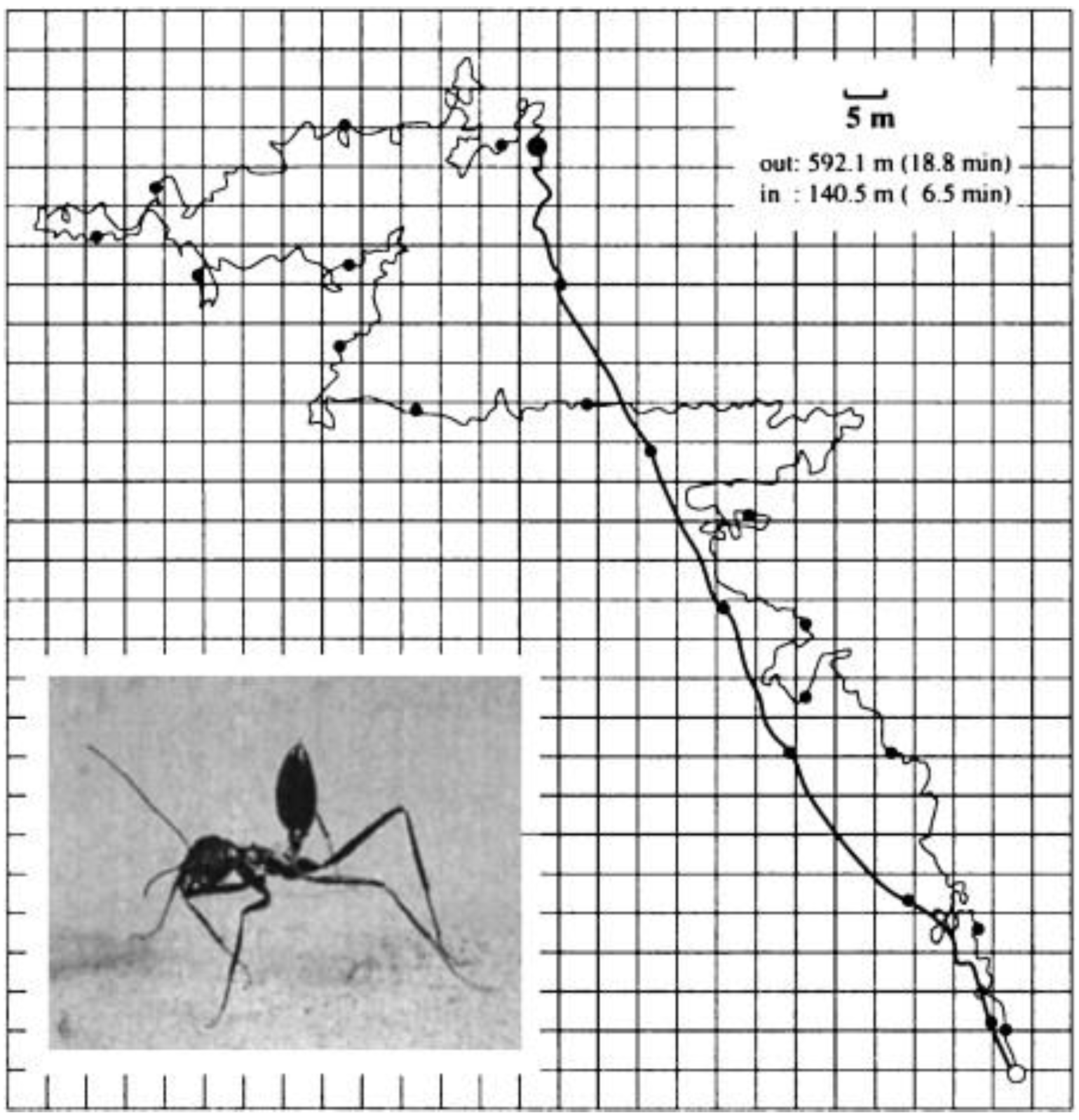

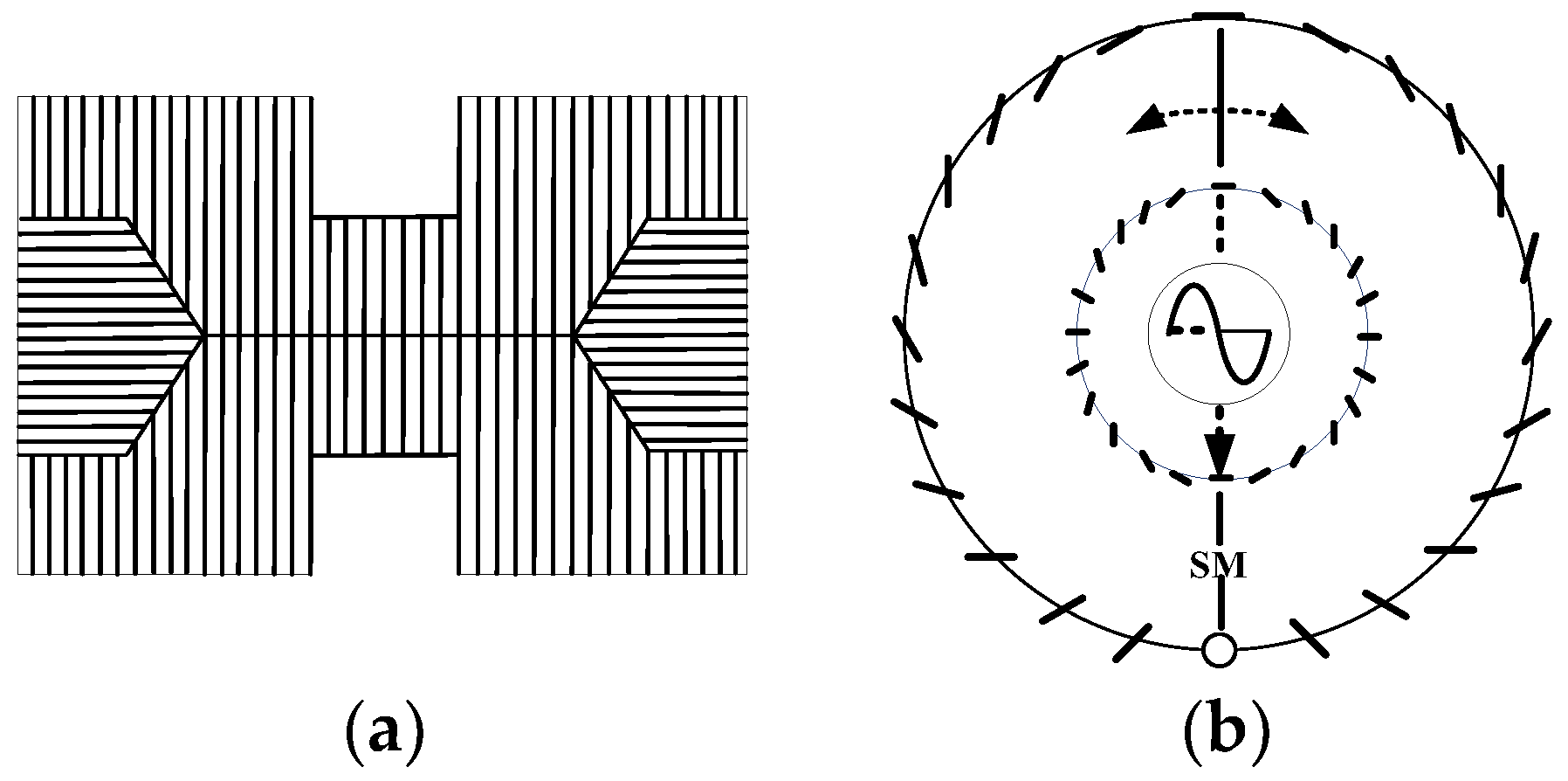



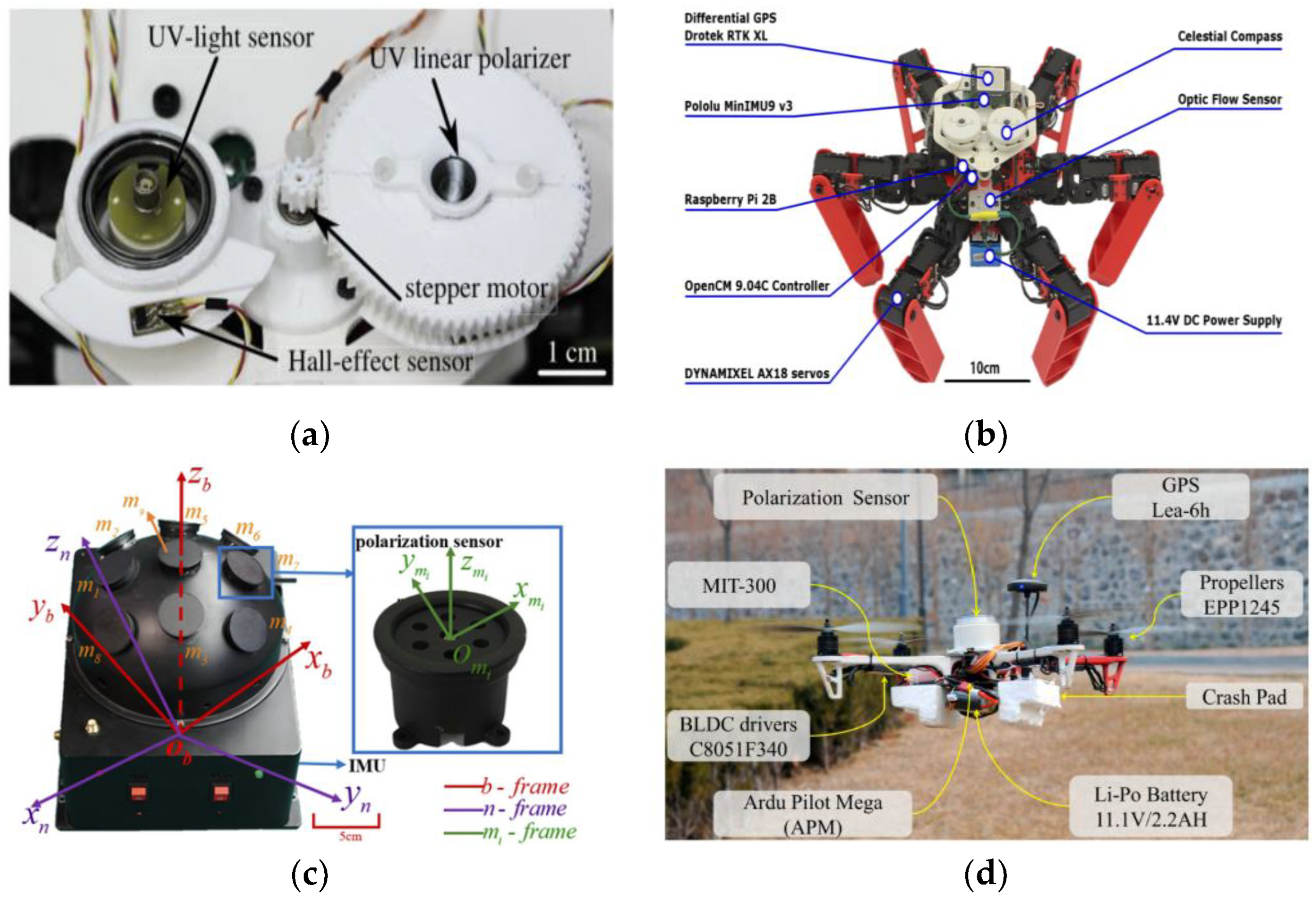



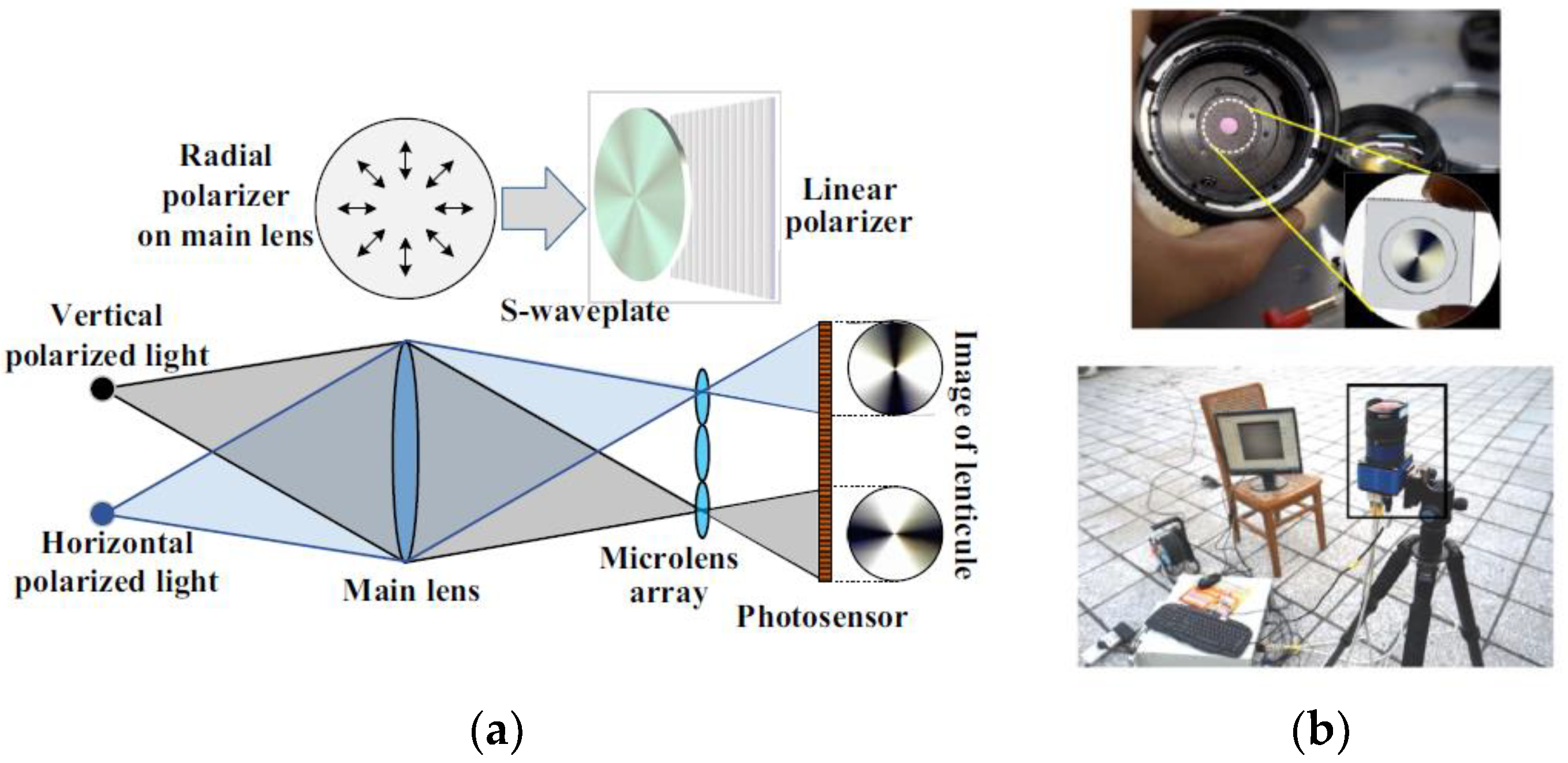



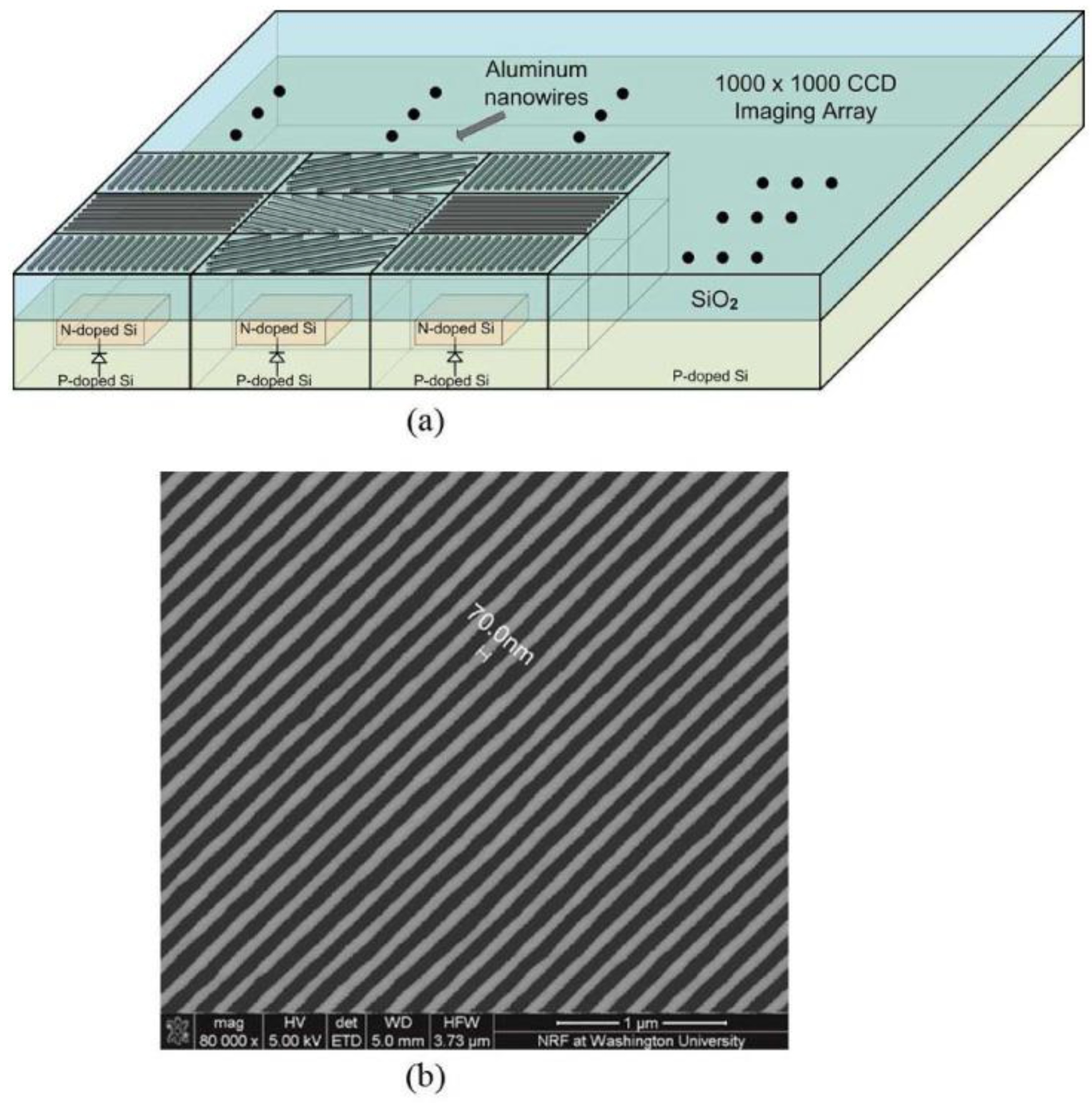

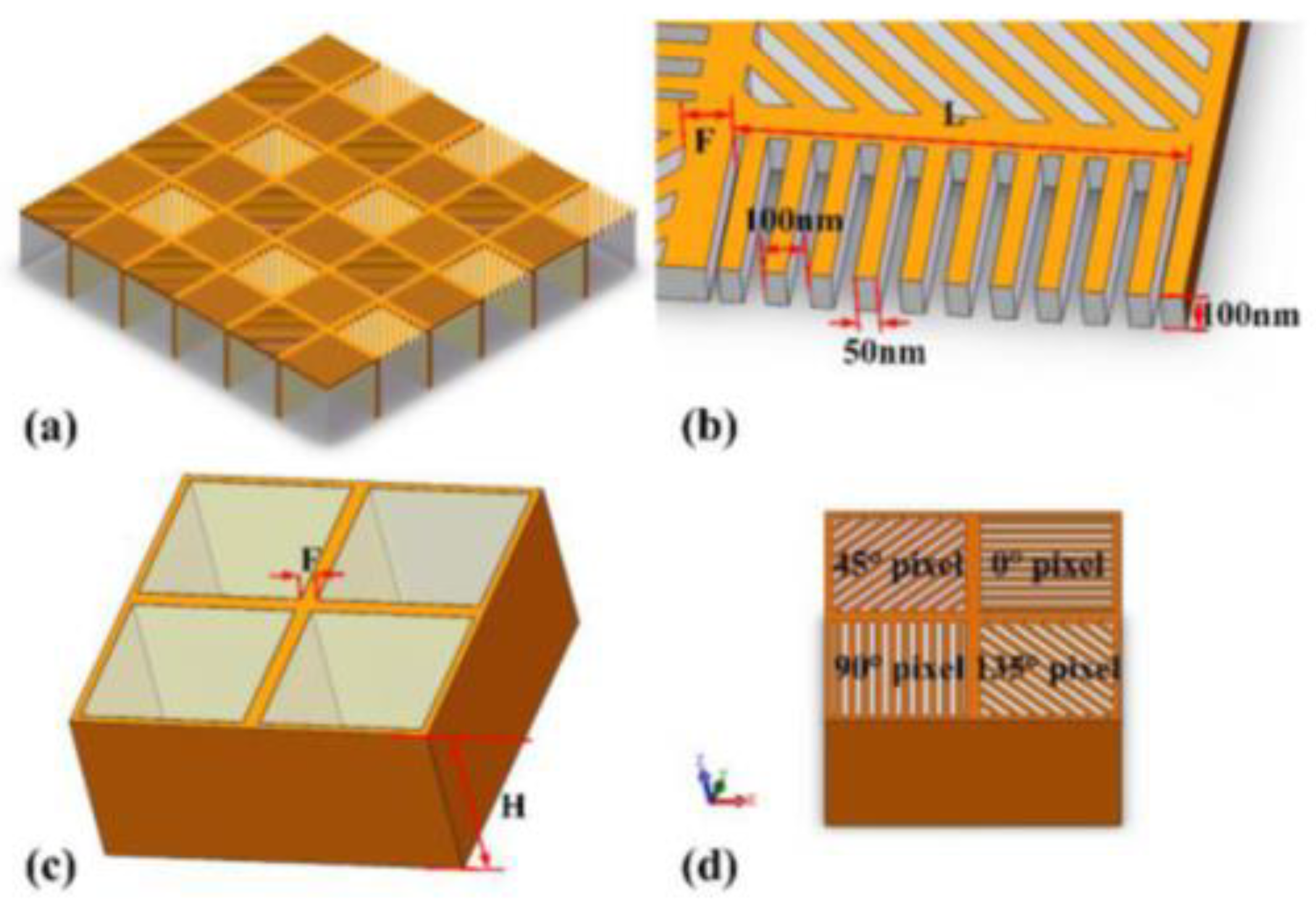


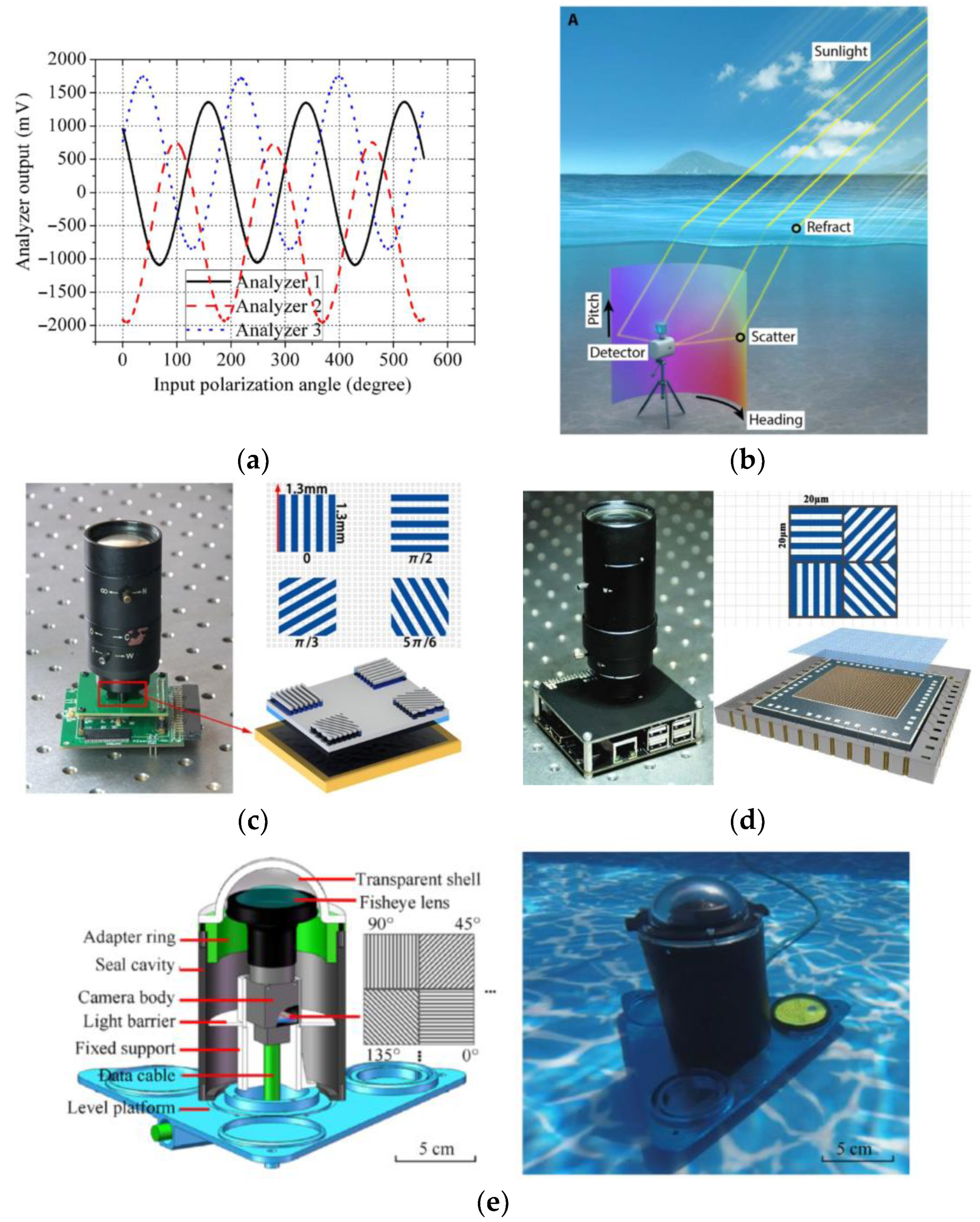
| Sensor Classification | System Composition | Typical Sensor | Reference | Advantages | Disadvantages | |
|---|---|---|---|---|---|---|
| Point source polarized light sensor | Basic point source sensor | Photodiode, polarizer, filter | 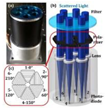 | [3,4,5,18,31,32,33,34,35,36,37] | Simple structure, small volume, and cost. | It is easy to be disturbed by the external environment and has poor stability. |
| Point source sensor for integrated navigation | Polarized light navigation, micro inertial navigation, Global Positioning System (GPS) navigation | 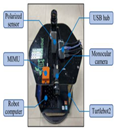 | [38,39,40,41,42,43,44,45,46,47,48,49,50,51,52,53,54,55,56] | Improve navigation performance and accuracy, and overcome the disadvantages of single sensor. | High production cost and large volume. | |
| Imaging polarized light sensor | Time-sharing imaging | Camera, turntable, polarizer | 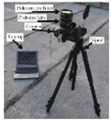 | [57,58,59,60,61,62,63,64,65,66,67,68,69,70] | Simple production and low cost. | The orientation error and assembly error are large. |
| Fractional amplitude imaging | Camera, polarization beam splitter, delayer |  | [71,72,73,74] | Multidirectional polarization angle image detection is available. | Due to the large volume and different imaging brightness of different detectors, the orthogonal error of polarizers is inevitable. | |
| Aperture splitting | Light field camera is usually used |  | [75,76,77] | It can image polarization images of multiple polarization states of the target scene in real time. | The requirements for lens and optical structure are high, and the relative sensitivity of noise leads to large polarization image error. | |
| Focal plane light splitting | Charge coupled device (CCD) camera, complementary metal oxide semiconductor (CMOS) camera, pixelated polarization array | 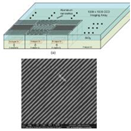 | [78,79,80,81,82,83,84,85,86,87,88,89,90,91,92,93,94,95,96] | Good real-time performance, high precision, and high integration. | High fabrication cost and nanowire error lead to inconsistent optical response of polarizers in different directions. | |
| Authors | Years | Reference | Sensor Type | Navigation Mode | Whether It Can Work in the Electromagnetic Interference Environment | Spectrum Detection Range | Technical Solutions | Main Technologies/Algorithms/Contributions |
|---|---|---|---|---|---|---|---|---|
| Dimitrios Lambrinos et al. | 1997 | [2] | Basic point source polarized light sensor | Polarized light navigation | Yes | Blue light | Photodiode | Scheme of polarized light navigation |
| 2000 | [3] | Blue light | Path integration and visual navigation mechanism | |||||
| Jinkui Chu et al. | 2008 | [4] | Blue light | A new polarized light sensor | ||||
| Evripidis Gkanias et al. | 2019 | [32] | Ultraviolet | Correction of sensor array tilt algorithm | ||||
| Javaan Chahl et al. | 2012 | [31] | Green light and ultraviolet light | Polarized light compass and its calibration method | ||||
| Kaichun Zhao et al. | 2009 | [33] | 400 nm–520 nm | Angle output algorithm | ||||
| Yinlong Wang et al. | 2019 | [34] | 320 nm–730 nm | Centrally symmetric algorithm, discontinuous algorithm | ||||
| Julien Dupeyroux et al. | 2019 | [35] | 270 nm–375 nm | Two-pixel polarized light sensor | ||||
| 2019 | [18] | 270 nm–375 nm | Waterproof ultraviolet polarized light sensor |
| Authors | Years | Reference | Sensor Type | Navigation Mode | Whether It Can Work in the Electromagnetic Interference Environment | Spectrum Detection Range | Technical Solutions | Main Technologies/Algorithms/Contributions |
|---|---|---|---|---|---|---|---|---|
| Dupeyroux et al. | 2019 | [38] | Point source sensor for integrated navigation | Polarized navigation/GPS | No | 270 nm–375 nm | Photodiode | Path integral integrated navigation strategy |
| Du et al. | 2020 | [39] | Polarized navigation/SINS | Yes | 400 nm–700 nm | Ambient light sensor | Static autonomous initial alignment algorithm | |
| Liu et al. | 2021 | [40] | Polarized navigation/MIMU | Yes | 400 nm–700 nm | Ambient light sensor | Bionic attitude and heading reference system | |
| Chu et al. | 2009 | [44] | Polarized navigation/GPS | No | Blue light | Photodiode | Design of fuzzy logic controller | |
| Chu et al. | 2018 | [45] | Polarized navigation/MIMU/GPS | Yes | Blue light | Photodiode | Attitude determination system assisted by polarized light sensor | |
| Wang et al. | 2015 | [46] | Polarized light navigation/geomagnetic navigation | No | Blue light | Photodiode | Combined positioning of polarized light and geomagnetic field | |
| Wang et al. | 2018 | [47] | Polarized light navigation/gravitational field/geomagnetic field | No | Blue light | Photodiode | Orthogonal vector algorithm | |
| Zho et al. | 2021 | [49] | Polarized navigation/MIMU | Yes | 400 nm–700 nm | Integrated polarization sensor | Sensor joint calibration algorithm and adaptive integration algorithm | |
| Xie et al. | 2021 | [50] | Polarized light navigation/MIMU/magnetometer | No | 400 nm–700 nm | Polarization based camera | Dead reckoning algorithm | |
| Fan et al. | 2022 | [51] | Polarized navigation/MIMU | Yes | 400 nm–700 nm | Polarization based camera | Optimal orientation algorithm and two-dimensional visual position recognition technology | |
| Fan et al. | 2022 | [52] | Polarized navigation/INS | Yes | 400 nm–700 nm | Polarization based camera | Robust bionic polarization skylight orientation algorithm and polarization mode consistency algorithm | |
| Hu et al. | 2021 | [54] | Polarized navigation/MIMU | Yes | 400 nm–700 nm | Ambient light sensor | Adaptive partial feedback algorithm for attitude angle | |
| Zhao et al. | 2022 | [55] | Polarized navigation/MIMU/GNSS | No | 400 nm–700 nm | Polarization based camera | Heading error modeling and compensation algorithm for attitude change of polarization compass |
| Authors | Years | Reference | Manufacturing Technology | Technical Solutions | Main Technologies/Algorithms/Contributions |
|---|---|---|---|---|---|
| Liu et al. | 2015 | [81] | Nanoimprinting technology | Integrated polarization sensor | Applying statistical theory to interval division algorithm of polarization angle |
| Zhang et al. | 2019 | [82] | Nanoimprinting technology, inductively coupled plasma etching (ICP), thermal evaporation process | Camera-based | Segmental local adaptive threshold segmentation and convolution interpolation algorithm |
| Liu et al. | 2022 | [83] | Flexible nano-imprint technology | Integrated polarization sensor | Multi-threshold segmentation algorithm |
| Ze Liu et al. | 2022 | [84] | Nanoimprint lithography process | Integrated polarization sensor | Combining traditional optical imprinting technology with nanoimprinting technology |
| Gruev et al. | 2010 | [87] | Electron beam evaporation deposition technology, reactive ion etching (RIE) technology | Integrated polarization sensor | Monolithic integration of polarization array and CCD imaging array |
| Sasagawa et al. | 2013 | [88] | 65 nm standard CMOS technology | Integrated polarization sensor | Using deep submicron CMOS technology to design fine metal patterns smaller than visible light wavelength |
| Zhang et al. | 2014 | [89] | 65 nm standard CMOS technology | Integrated polarization sensor | The design of grid array is guided by numerical analysis |
| Garcia et al. | 2018 | [90] | 180 nm standard CMOS technology | Integrated polarization sensor | A polarization imaging sensor with high dynamic range is proposed |
| Momeni et al. | 2006 | [110] | 1.5 micron double-n-well CMOS process, lithography and deposition technology | Integrated polarization sensor | Install the birefringent micro-polarizer on the CMOS chip |
| Sarkar et al. | 2010 | [111] | 180 nm standard CMOS technology | Integrated polarization sensor | Polarization sensor with high integration |
| Gruev et al. | 2011 | [112] | Interference lithography process and micromachining process | Integrated polarization sensor | Fabrication of micro-polarization array by interference lithography and micromachining |
| Shengkui Gao et al. | 2013 | [113] | Electron beam lithography (EBL), reactive ion etching (RIE) | Integrated polarization sensor | Preparation of aluminum pixelated polarization structure by electron beam lithography (EBL) and reactive ion etching (RIE) |
| Chuanlong Guan et al. | 2022 | [114] | Ultraviolet nanoimprinting technology (UV-NIL) | Integrated polarization sensor | Sensor calibration method based on discrete Fourier transform and relative entropy |
| Kiyotaka Sasagawa et al. | 2022 | [115] | 0.35 micron standard CMOS technology | Integrated polarization sensor | An optical system with a two-layer structure, including an external polarizer and a polarizer on a pixel array |
| Hongxia Zheng et al. | 2022 | [116] | 65 nm 1P8MCMOS process | Integrated polarization sensor | Metal grid structure with dual operation modes |
Disclaimer/Publisher’s Note: The statements, opinions and data contained in all publications are solely those of the individual author(s) and contributor(s) and not of MDPI and/or the editor(s). MDPI and/or the editor(s) disclaim responsibility for any injury to people or property resulting from any ideas, methods, instructions or products referred to in the content. |
© 2023 by the authors. Licensee MDPI, Basel, Switzerland. This article is an open access article distributed under the terms and conditions of the Creative Commons Attribution (CC BY) license (https://creativecommons.org/licenses/by/4.0/).
Share and Cite
Li, S.; Kong, F.; Xu, H.; Guo, X.; Li, H.; Ruan, Y.; Cao, S.; Guo, Y. Biomimetic Polarized Light Navigation Sensor: A Review. Sensors 2023, 23, 5848. https://doi.org/10.3390/s23135848
Li S, Kong F, Xu H, Guo X, Li H, Ruan Y, Cao S, Guo Y. Biomimetic Polarized Light Navigation Sensor: A Review. Sensors. 2023; 23(13):5848. https://doi.org/10.3390/s23135848
Chicago/Turabian StyleLi, Shunzi, Fang Kong, Han Xu, Xiaohan Guo, Haozhe Li, Yaohuang Ruan, Shouhu Cao, and Yinjing Guo. 2023. "Biomimetic Polarized Light Navigation Sensor: A Review" Sensors 23, no. 13: 5848. https://doi.org/10.3390/s23135848
APA StyleLi, S., Kong, F., Xu, H., Guo, X., Li, H., Ruan, Y., Cao, S., & Guo, Y. (2023). Biomimetic Polarized Light Navigation Sensor: A Review. Sensors, 23(13), 5848. https://doi.org/10.3390/s23135848






